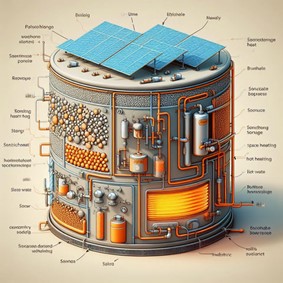
Written by Margarita Kyrkou, Rural-Surveying engineer & GIS Specialist at Wattcrop.
The quest for sustainable energy solutions has driven innovation across various technologies, with thermal energy storage (TES) emerging as a pivotal player in harnessing and utilizing heat from renewable sources. TES systems offer an efficient and adaptable way to store excess energy, particularly from intermittent renewable sources like solar and wind, and deploy it when demand peaks or supply diminishes. This article explores TES’s principles, technologies, and benefits, highlighting its role in the global transition to clean energy.
Understanding Thermal Energy Storage
Thermal Energy Storage involves capturing and retaining heat energy for later use. Unlike electrical energy storage systems like batteries, which store electricity, TES systems store thermal energy in the form of heat. This heat can be sourced from a variety of renewable sources, including solar thermal power, geothermal energy, and even excess heat from industrial processes. The storage medium can be solid, liquid, or phase-change materials, each with distinct advantages and applications.
Key Components of TES:
- Sensible Heat Storage: This method involves heating a solid or liquid storage medium (like water, molten salts, or rocks) and storing the heat as an increase in the temperature of the medium. Water tanks and molten salt tanks are common examples.
- Latent Heat Storage: Latent heat storage utilizes phase change materials (PCMs) that absorb and release heat during their transition between solid and liquid states. PCMs can store large amounts of heat at nearly constant temperatures, making them efficient for maintaining specific temperature ranges.
- Thermochemical Storage: This advanced method involves reversible chemical reactions to store and release heat. Thermochemical storage has high energy density and can store heat for long durations with minimal losses, though it is currently less common due to its complexity and cost.
Harnessing Renewable Heat
TES systems are particularly effective in capturing heat from renewable sources such as solar thermal, geothermal, and biomass energy.
- Solar Thermal Energy:
- Solar thermal systems collect and concentrate sunlight to generate heat, which can be stored in TES systems for later use. This is particularly beneficial for ensuring a stable energy supply during cloudy periods or at night.
- Concentrated solar power (CSP) plants often use molten salt as a storage medium, retaining high-temperature heat that can be converted to electricity on demand.
- Geothermal Energy:
- Geothermal plants extract heat from the Earth’s core, which can be stored in TES systems for continuous energy supply. This enhances the reliability and efficiency of geothermal power.
- Biomass Energy:
- Biomass energy, derived from organic materials, produces heat during combustion or biochemical processes. TES can capture this heat for industrial processes or district heating systems.
Applications and Benefits
TES systems offer versatile applications across residential, commercial, and industrial sectors, providing a range of benefits:
- Grid Stability and Efficiency: By storing excess energy during periods of low demand and releasing it during peak times, TES enhances grid stability and reduces the need for fossil fuel-based peaking power plants.
- Energy Cost Savings: TES systems can lower energy costs by enabling the use of cheaper, off-peak electricity for heating and cooling purposes.
- Reduced Greenhouse Gas Emissions: TES facilitates the integration of renewable energy sources, reducing reliance on fossil fuels and lowering greenhouse gas emissions.
- Improved Energy Security: By diversifying energy storage options, TES contributes to energy security and resilience against supply disruptions.
Challenges and Future Prospects
Despite its potential, TES faces challenges such as high initial costs, material degradation, and efficiency losses. Research and development efforts are focused on improving storage materials, reducing costs, and integrating TES with other energy systems.
Innovative solutions like hybrid storage systems, combining TES with electrical storage technologies, are emerging to address these challenges. Advances in materials science are also paving the way for more efficient and durable storage media.
Thermal energy storage stands as a cornerstone in the pursuit of sustainable energy solutions. By capturing and utilizing heat from renewable sources, TES systems not only enhance energy efficiency and grid stability but also play a crucial role in mitigating climate change. As technology advances and costs decline, TES is poised to become an integral component of the global clean energy landscape, driving us toward a more resilient and sustainable future.

